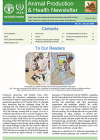Nutritious feeds and forages constitute a major input for a healthy and productive livestock industry. Using nuclear and related technologies, we help optimize feed resources and feeding practices needed to address both current deficits and future demands of food production from animals.
Animal nutrition
Feeds and forages constitute the major operation costs of any livestock enterprise. However, they – even counted together with grass and pasture lands – are not enough to meet today’s demands of the livestock industry. Other factors further compound the problem: Available feed supplies, often scarce, are fluctuating in quantity and quality; many native pastures and crop residues suffer from a nutrient imbalance; and commercial concentrate feeds, which could provide additional protein sources, are lacking, or their use is limited. A rapidly increasing human population, coupled with degrading soil and land, increasing urbanization and industrialization, and the effects of climate change, also take their toll.
Jointly with the FAO, the IAEA assists its Member States in developing and adopting nuclear-based technologies to optimize feed resources and identify innovative feeding practices that strengthen livestock productivity and help meet the growing demand of food from animal origin.
Innovation and new technologies can help optimise livestock feeds production
To close the gap between shrinking resources and increasing demand, the individual uses of local feed resources, such as natural grasslands, ranch lands and cultivated pastures, must be optimized. This process also needs to reach out to the brewing and other agro-industries; and it must involve anything from food waste, by-products of grains and crop residues; to biofuel, cut-and-carry grasses, and plants and plant products that are lesser known and not traditionally used as animal feeds.
The optimization of resource use needs to be based on continuing innovation and validation of technologies. Research and development is needed to develop methodologies and guidelines for the breeding of grasses that can grow in harsh climates and grow faster under conditions with short growing periods, but yield at the same time a greater biomass with greater digestibility for animal consumption.
This requires continued testing of potential feed resources for nutrient contents in laboratories and field trials. On the basis of these test results, farmers can replace conventional animal feedings partially or entirely with more innovative feeding practices using local resources, impacting directly on livestock productivity while protecting the environment and conserving natural resources.
How nuclear and isotopic techniques can contribute
A combination of n-alkane profiles with natural carbon-13 concentration in plant species eaten by ruminants and traceable in their faeces can be used to determine their feed intake under grazing or browsing conditions. Carbon-14 is used to determine the relationship between purine (an organic compound) absorption and purine derivatives excretion in urine, reflecting the efficiency of microbial digestions in the rumen (the first chamber in the alimentary canal of ruminant animals).
The rate of microbial protein synthesis is determined by phosphorus-32, phosphorus-33, nitrogen-14 or sulphur-35 incorporation in the rumen microorganisms. Labelled minerals such as phosphorus-32, selenium-75, calcium-45, arsenic-76 and copper-67 are used to investigate mineral imbalances in farm animals. Methane emission by ruminants can be estimated by isotope dilution using either hydrogen-3 or carbon-14 labelled methane.






